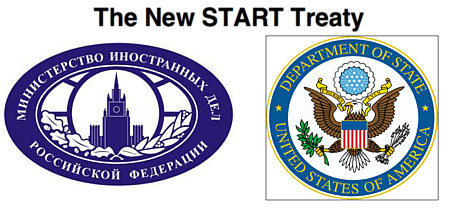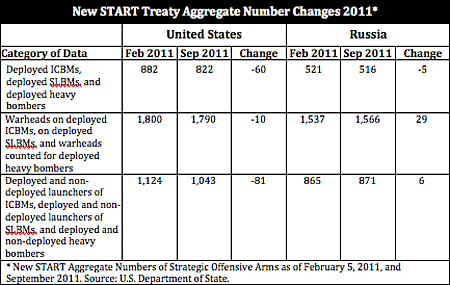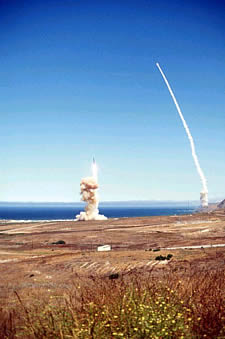New START Data: Modest Reductions and Decreased Transparency
 |
| New START aggregate numbers have been published by the United States and Russia. |
.
By Hans M. Kristensen
The latest New START treaty aggregate numbers of strategic arms, which was quietly released by the State Department earlier last week, shows modest reductions and important changes in U.S. and Russian strategic nuclear forces.
Most surprisingly, the data shows that Russia has increased its number of deployed strategic nuclear warheads and is now again above the New START limit.
Because of the limited format of the released aggregate numbers, however, the changes are not explained or apparent. As a result, though not yet one year old, the New START treaty is already beginning to increase uncertainty about the status of U.S. and Russian nuclear forces.
Overall Changes
Combined, the data shows that the United States and Russia as of September 2011 deployed 3,356 nuclear warheads on 1,338 strategic delivery vehicles, down from 3,337 warheads on 1,403 delivery vehicles in February 2011.
A modest combined reduction of 65 delivery vehicles in seven months, but an increase of 19 warheads; apparently they two nuclear superpowers are not in a hurry to reduce.
 |
| The New START aggregate data shows modest reductions in strategic delivery vehicles and a Russian increase of deployed strategic warheads. |
.
The aggregate numbers not include thousands of additional strategic and non-strategic warheads that are not counted by the treaty. To put things in perspective, the U.S. military stockpile includes nearly 5,000 warheads; the Russian stockpile probably about 8,000. In addition, thousands of retired, but still intact, warheads are in storage for a total combined U.S. and Russian inventory of perhaps 19,000 warheads.
Russia
Most surprising is that the New START data erases Russia’s achievement from earlier this year when its number of deployed strategic warheads temporarily dipped below the treaty limit of 1,550 warheads. According to the new data, Russia has slightly increased (by 29) the number of warheads deployed on its ballistic missiles and now stands 16 warheads above the treaty limit.
The warhead increase comes at the same time that the number of delivery vehicles has declined by five. But since the New START aggregate data – unlike the previous START treaty – does not include a breakdown of missile types, it is impossible to see where the change happened. As a result, transparency of Russia’s strategic nuclear forces is decreasing.
Part of the explanation is the deployment of additional RS-24 ICBMs, which carry three warheads each. But that’s a limited deployment that doesn’t account for all. Other parts of the puzzle include continued reduction of the single-warhead SS-25 ICBM force, the operational status of individual Delta IV SSBNs, and possibly retirement of one of the aging Delta III SSBNs.
The United States
The New START data shows that the United States only removed 10 warheads from its ballistic missiles during the previous seven months, down from 1,800 to 1,790 warheads.
The number of delivery vehicles declined by 60, from 882 to 822, a change that probably reflects the removal of nuclear-capable equipment from so-called “phantom” bombers. These bombers are counted under the treaty even though they are not actually assigned nuclear missions. The U.S. has not disclosed the number, but another 24, or so, “phantom” bombers probably need to be denuclearized. Stripping these aircraft of their leftover equipment reduces the number of nuclear delivery vehicles counted by the treaty, although it doesn’t actually reduce the nuclear force.
Later this decade will come a gradual reduction of the number of SLBMs deployed on SSBNs from 288 to 240. Likewise, if the bomber force is retained, the ICBM force might be reduced to 400 missiles from 450 today.
Conclusions
The New START data shows that Russia and the United States have gotten off to a slow start and excessive nuclear secrecy is reducing the international community’s ability to monitor and analyze the changes.
Russia essentially has seven and half years to offload 16 warheads from its force to be in compliance with New START by 2018. Not an impressive arms control standard. Instead, the task for Russian planners will be how to phase out old missiles and phase in new missiles. There will be no real constraint on the Russian force.
 |
| The United States ICBM force could be a big as Russia’s entire triad by the mid-2020s. |
The new data underscores the substantial lead the United States has over Russia in strategic nuclear delivery vehicles. Even as Russia deploys the RS-24 ICBM and Bulava SLBM in the coming years, the gradual retirement of the SS-18, SS-19, SS-25 and SS-N-18 could reduce the total number of delivery vehicles to perhaps 400 by the time the New START treaty enters into force in 2018.
In contrast, under current plans, the United States intends to retain 700 strategic delivery vehicles by 2018. Without additional unilateral reductions, the United States could end up with 50 percent more strategic delivery vehicles than Russia in its triad by the turn of the decade. Indeed, the U.S. ICBM force alone could at that time include as many delivery vehicles as the entire Russian triad!
The U.S. force will retain a huge upload capability with several thousand non-deployed nuclear warheads that can double the number of warheads on deployed ballistic missiles if necessary. Russia’s ballistic missile force, which is already loaded to capacity, does not have such an upload capability.
This disparity creates fear of strategic instability and is fueling worst-case planning in Russia to deploy a new “heavy” ICBM later this decade.
To prevent a deepening of this trend, the Obama administration’s ongoing nuclear targeting review (see also forthcoming article in Arms Control Today) must significantly reduce the excessive nuclear posture currently planned under New START.
This publication was made possible by a grant from Carnegie Corporation of New York and Ploughshares Fund. The statements made and views expressed are solely the responsibility of the author.
While it is reasonable for governments to keep the most sensitive aspects of nuclear policies secret, the rights of their citizens to have access to general knowledge about these issues is equally valid so they may know about the consequences to themselves and their country.
Nearly one year after the Pentagon certified the Sentinel intercontinental ballistic missile program to continue after it incurred critical cost and schedule overruns, the new nuclear missile could once again be in trouble.
“The era of reductions in the number of nuclear weapons in the world, which had lasted since the end of the cold war, is coming to an end”
Without information, without factual information, you can’t act. You can’t relate to the world you live in. And so it’s super important for us to be able to monitor what’s happening around the world, analyze the material, and translate it into something that different audiences can understand.